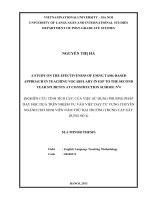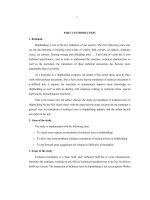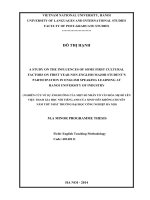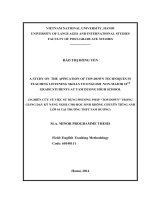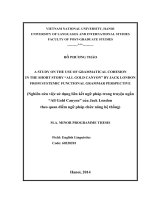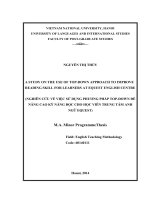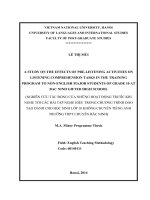A study on the difficulties faced by the Front Office Staffs at Super hotel in Hanoi old quarter in communicating in English and some recommended solutions
Bạn đang xem bản rút gọn của tài liệu. Xem và tải ngay bản đầy đủ của tài liệu tại đây (413.38 KB, 48 trang )
THUONGMAI UNIVERSITYENGLISH FACULTY
------
GRADUATION PAPER
DIFFICULTIES IN COMMUNICATING IN ENGLISH
WITH FOREIGNERS: THE CASE OF ENGLISH
MAJORS AT THUONGMAI UNIVERSITY
Supervisor: Mrs Tran Thi Bich Lan , M.A
Student: Nguyen Thi Thu Uyen
Class: K53N6
Student’s number: 17D170341
Hanoi - 2020
Hanoi - 2020
HÀ NỘI - 2016
ABSTRACT
Over time, the society has become more and more integrated. Therefore, a
second language besides the mother tongue is a useful tool to help us get closer to
the quintessence of humanity. Because of that, English is considered the second
most widely studied and popular language in the world. In English skills,
communication skill can be considered as the most important skill. However, during
the learning and communication process, learners also make some mistakes that
need to be overcome to improve this skill better.
Having learning this language since being at school, I would like to discuss the
difficulties in communication in English with foreigners of the English-majored
students in the English Faculty at Thuongmai University. And this is also the topic
of my graduation thesis. The survey is conducted with the students of the English
Faculty to collect survey data. Finally, I propose some right solutions for students to
overcome difficulties when practicing speaking skill.
I hope that this study will bring students awareness of the difficulties in
learning communication skill and refer to some useful solutions that will help them
improve their communication skill.
1
ACKNOWLEDGEMENTS
Although doing study in a limited time, I received a lot of enthusiastic help
from so many people to complete this graduation paper. I greatly appreciate the
enthusiastic supports.
First of all, I would like to express my deepest gratitude and profound thanks
to Mrs. Tran Thi Bich Lan, one of the enthusiastic lectures of the English Faculty at
Thuongmai University and my supervisor. Thanks to the thoughtful guidance, I
finished the graduation thesis in the most complete way. Without any help of her, I
can hardly finish this graduation thesis.
Secondly, I am sincerely thankful to all the English-majored students in the
English Faculty who helped me a lot in this study. They helped me complete the
survey and provided me with important data from the questionnaire so that I could
analyze and provide the best suggestions for my research.
Last but not least, I want to thank my family and my close friends for
supporting me. They helped me to be more spiritual and create good conditions for
me to complete my graduation paper well. I wish to thank all who have kindly given
their advice with source materials during writing.
I know my graduation paper still have mistakes due to my shortcomings. I
would like to receive your comments, suggestions and corrections for the perfect of
my own graduation paper.
Hanoi, November 22, 2020
Student
Nguyen Thi Thu Uyen
2
TABLE OF CONTENTS
ABSTRACT..............................................................................................................i
ACKNOWLEDGEMENTS....................................................................................ii
TABLE OF CONTENTS.......................................................................................iii
LIST OF TABLES...................................................................................................v
CHAPTER 1: OVERVIEW OF THE STUDY......................................................1
1.1. RATIONALE....................................................................................................1
1.2. PREVIOUS STUDIES.....................................................................................1
1.3. AIMS OF THE STUDY....................................................................................3
1.4. RESEARCH SUBJECT...................................................................................4
1.5. SCOPE OF THE STUDY.................................................................................4
1.6. RESEARCH METHODOLOGY....................................................................4
1.6.1. Instrumentation..............................................................................................4
1.6.2. Data collection procedures.............................................................................5
1.6.3. Data analysis methods....................................................................................5
1.7. ORGANIZATION OF THE STUDY..............................................................6
CHAPTER 2: LITERATURE REVIEW...............................................................7
2.1. What is communication....................................................................................7
2.2. The importance of communication in our life................................................7
2.3. Types of communication...................................................................................9
2.3.1. Verbal communication....................................................................................9
2.3.2. Nonverbal communication...........................................................................10
2.3.3. Written communication.................................................................................11
2.3.4. Visual communication..................................................................................12
2.4. Process of communication..............................................................................12
2.5. Importance of English communication skills...............................................15
2.6. Barriers to effective communication.............................................................18
CHAPTER 3: RESEARCH FINDINGS..............................................................22
3.1. Introduction....................................................................................................22
3.2. Findings and discussion..................................................................................22
3
3.2.1. Findings........................................................................................................22
3.2.2. Students’ attitudes toward communicating in English with foreigners.......25
3.2.3. Difficulties of students in communicating in English with foreigners........26
3.2.4. Strategies to improve communication skill in English with foreigners......30
3.2.5. Discussion.....................................................................................................31
CHAPTER 4: RECOMMENDATIONS AND SUGGESTIONS........................32
4.1. Limitations......................................................................................................32
4.2. Recommendations...........................................................................................32
4.3. Some suggestions for further research..........................................................35
CONCLUSION......................................................................................................36
REFERENCE
APPENDIX
4
LIST OF TABLES
Tables
Chart 3.1
Chart 3.2
Chart 3.3
Table 3.1
Chart 3.4
Table 3.2
Chart 3.5
Table 3.3
Chart 3.6
Chart 3.7
Content
Page
Respondents’ level of English communication with
23
foreigners
Students’ chances to communicate in English with
24
foreigners
Students’ attitudes toward communicating in English with
25
foreigners
Difficulties related to linguistics
26
Difficulties related to linguistics
26
Difficulties related to psychology
27
Difficulties related to psychology
28
Difficulties related to communication culture
29
Difficulties related to communication culture
29
Strategies to improve communication skill in English with
30
foreigners
5
CHAPTER 1: OVERVIEW OF THE STUDY
1.1. RATIONALE
It is said that “ Study must be accompanied by practice”. It is completely right
since if we are good at theory but we can not use it in reality, we can not succeed in
work. Practice is the best way to apply what we have learned in reality. By
practicing, we can get acquainted with our future job and improve our skills.
There is an undeniable fact that today communication skill and especially
communication in English plays a very important role in the development of human
society. It is estimated that there are around 5000 languages in the world. Of those,
English is still chosen as a global language. It is the main language used on the
Internet, business and many others fields. There are many advantages but also many
difficulties in learning English and the process is often challenging, especially for
students. They have a lot of time but have one disease - laziness, lack of
perseverance. In addition, there are also other reasons such as the unique
characteristics of English vocabulary, grammar, pronunciation.
I major in English at Thuongmai university but I do not have enough time to
practice and only have a little opportunity to talk with foreigners. During my study
process at Thuongmai university, I found many difficulties that I and English major students encounter when communicating in English with foreigners. That is
why I choose the subject of study as “ Difficulties in communicating in English
with foreigners: the case of English majors at Thuongmai universities”. I hope that
through this research topic, I will point out some difficulties in communicating in
English with foreigners and offer some solutions to overcome obstacles and
improve this skill in the best way.
1.2. PREVIOUS STUDIES
We all know that English has become an international language. That is the
reason why a lot of researchers and scholars conduct research and analyze it. There
have been lots of international and local studies which have been done recently
relating to English learning. For example, Alqahtani Mofareh A (September, 2019)
1
addresses the poor language proficiency of English language students, particularly
in terms of their conversational skills and/or ability to achieve the desired standards
of fluency in either the classroom environment or public sphere. The many factors
which directly affect students' performance in speaking fluent English include the
fear of making errors. The present study therefore aims to identify the perceived
difficulties which language students associate with the study and utterance of
English. To this end, the conducted research was descriptive in nature and sought to
determine the various elements which are perceived as especially challenging for
students and to devise effective solutions through appropriate teaching styles,
methodologies and strategies which are driven and supported by the relevant
contemporary technology. In addition to fear, certain factors relate to individuated
student character and practices, and many students report feelings of shyness and
potential embarrassment. Distrust also constitutes a significant obstacle, along with
issues surrounding teaching methods, teacher inefficiency, or the lack of up-to-date
pedagogies. To fully investigate this issue, a quantitative survey instrument
containing multiple questions was undertaken in addition to a number of interviews
with a random sample of students and teachers in order to elicit the main student
challenge in speaking English. The results demonstrated that the majority of the
students were unable to speak English either correctly or confidently. The
percentages which varied between average, weak, and very weak, were attributed to
a general weakness in English grammar, vocabulary, syntax, poor fluency in speech,
low understanding of overall grammar frameworks, and inaccurate pronunciation.
In light of this, the present study sought to provide useful suggestions to resolve
student conversational problems. To this end, the researcher elucidated the research
problem, importance, objectives, hypotheses and methodologies, as well as drawing
conclusions. Finally, the researcher outlined a number of recommendations directly
relevant to resolving the complex.
In Vietnam, there are also many studies related to this field. For instance, in
the study “A study on the difficulties faced by the Front Office Staffs at Super hotel
in Hanoi old quarter in communicating in English and some recommended
solutions” by Duong Thu Nga, Thuongmai University (2018). The research was
2
based on the data collected from the questionnaires for the Front Office Staffs in the
Super Hotel in Ha Noi Old Quarter with the aim of finding out their difficulties
when communicating with customers in English. The questionnaire has been
designed and sent to 20 Front Office Staffs to research some barriers prevent them
from a successful English communication with foreign guests especially Japanese
guests. Research results showed that the causes of problems occurring during
English communication with customers are the differences in intonations of each
country, cultural differences, etc.
From the difficulties and the situation of communicating in English with
customers and the main reasons the author recommended the solutions to improve
the communication skills of English receptionist staff at Super Hotel Ha Noi Old
Quarter.
Besides, another study “English communication skills of students with
foreigners - proposing solutions to join NGOs” (2008), the author selected English major students from four typical universities in Hanoi: VNU University of
Languages and International Studies, Vietnam National University, Foreign Trade
University and Hanoi University of Science and Technology. Foreigners mentioned
in the study are good at English communication skills and qualifications, most of
whom are from Europe, Australia and North America using English as their mother
language. Research methodology used in the article is investigation, interview and
observation. The research results show that when students communicate with
English speakers in different countries, the most common difficulties they encounter
are intonation, accent and regional culture.
These are the highlight of the researches. Thereby we can see the different
aspects of the problem, have a deeper look and recognize the obstacles in
communicating in English with foreigners. From there, learners will be able to give
themselves the correct learning methods to improve.
1.3. AIMS OF THE STUDY
My research is to find solutions that help English - major students at
Thuongmai university overcome the difficulties they encounter in the English
3
communication process with foreigners. My research aims at the following basic
goals:
Cover background knowledge of communication
Analyze the situation of communication in English with foreigners by
English - major students at Thuongmai university and the difficulties encountered
by themselves
Provide solutions to improve English communication skills with
foreigners for English - major students at Thuongmai university
1.4. RESEARCH SUBJECT
The research subject is to find out the real difficulties faced by English - major
students at Thuongmai university in communication in English with foreigners.
1.5. SCOPE OF THE STUDY
Research topics are conducted on the scope of Thuongmai University. The
research focuses on the English - major students in the English Faculty at
Thuongmai University to point out their obstacles when communicating in English
with foreigners. The study is conducted in the first semester of the academic year
2020-2021. Due to time constraints, this study carries out about 100 randomly
selected students.
1.6. RESEARCH METHODOLOGY
In this study, the author decided to use the quantitative and descriptive
method. Quantitative research helps to survey the level of language difficulties in
communication process with foreigners. Descriptive research helps to list the
language difficulties encountered by students during communication process.
Moreover, a questionnaire is set up which includes both open-ended and closeended questions, allowing the respondents to give their opinions and views in the
most convenient way. The researcher would analyze the collected data and then
display the survey results in forms of charts and tables.
1.6.1. Instrumentation
According Brown (2001, cited in Markey & Gass, 2005), “Questionnaires are
any written instruments that present respondents with a series of questions or
4
statements to which they are to react, either by writing out their answers or selecting
from among existing answers”.
Markey & Gass (2005) see using questionnaires as an instrument which allows
researchers to gather information in such a short time with comparable information.
For that reason, the author decided to use the questionnaire to access
information. The questionnaire is easier to understand when written in Vietnamese,
ensuring participants understand the information in this survey. A questionnaire in
English is also set for reference. The questionnaire consists of two parts: general
information and research questions, including open-ended questions and selection
questions.
1.6.2. Data collection procedures
To increase the reliability and value of the study, a random sampling procedure
is applied in the survey questionnaire.
We survey 100 English-majored K53 students because these students studied
Advanced communication English got contact with native teachers. K53 of the
English faculty at Thuongmai University has 6 classes including K53N1, K53N2,
K53N3, K53N4, K53N5 and K53N6. In each class we will choose from 15 to 20
students until we have enough 100 answers. The questionnaire is carefully reviewed
before sending directly to the students of the English Department. The questionnaire
is also brief and clear for all students to understand and implement. Students are
asked to conduct surveys in the most objective way.
Finally, the researcher receives a complete questionnaire and re-check the
number of sheets.
1.6.3. Data analysis methods
Data analysis is a process of checking and transforming data with the aim of
highlighting information, helping researchers to make recommendations and
solutions.
In terms of the data collected in the questionnaire, the results are collected and
analyzed by Microsoft Excel software in percentage. After that, the data are
illustrated through charts and tables for a clear description of this finding, helping to
confirm the results from the survey questionnaire.
5
This research method saves research time and quickly gets research data
analysis.
1.7. ORGANIZATION OF THE STUDY
This study consists of four main parts:
Chapter 1: Overview of the study
General research topics include the reason for selecting this study, provide
previous research topics, aims of the study, identify research subjects, scope of the
study, research methodology and structure of this study.
Chapter 2: Literature review
This chapter gives an overview of what communication is, the importance of
communication in our life, types and process of communication, the importance of
English communication skills and barriers to effective communication. Thereby, the
author finds the difficulties that English learners encounter.
Chapter 3: Data analysis and research findings
This chapter examines students based on a set questionnaire. Through the
survey, the author learns the views of students about the difficulties in
communicating in English with foreigners. In addition, the author also analyzes the
results received and discussed.
Chapter 4: Recommendations and suggestions
This chapter proposes and suggests some solution to overcome difficulties in
communicating in English with foreigners in general and English - major students
of the English Faculty at Thuongmai University in particular.
6
CHAPTER 2: LITERATURE REVIEW
2.1. What is communication
There are many definitions of communication posed by different writers.
According to Dwyer (2000:4), “Communication is the transfer of meaning.
Communication is any behavior, verbal or nonverbal, that is perceived by another.
Knowledge, feelings or thoughts are encoded and sent from at least one person and
received and decoded by at least one other. Meaning is given to this message as the
receiver interprets the message. A connection is made between the people
communicating. Communication lets us learn more about ourselves and the world
around us, share experience with others, persuade and influence others, and relax
and enjoy ourselves.” Verderber, R.F., Verderber, K.S & Berryman- Fink, C. (2008)
define “communication is process of creating and sharing meaning in informal
conversation, group interaction, or public speaking”. Another definition is set by
Hybels, S & Weaver II, R.L. (1992). According to them, “communication is any
process in which people share information, ideas and feelings. That process
involves not only the spoken and written word, but also body, personal mannerisms
and style, the surroundings- anything that adds meaning to a message.”
From the definition, it can be summarized that Communication is the process
of sending and receiving information among people. It is a way of reaching others
by transmitting ideas and thoughts, feelings and values.
2.2. The importance of communication in our life
Ancient Greeks consider communication to be important for social cohesion
and democracy. Evidence to this are the creation of the ancient market, the
establishment of theatres etc. where people used to meet, exchange information and
good and where they had the opportunity to send and receive knowledge and ideas.
Several philosophers and prominent dramatic writers deal with the communication
as a form of teaching. Socrates, the philosopher, has been a warm supporter of
verbal word and the founder of the “dialectic theory”. He was the first to realize the
significance of communication for the youth’s and the citizen’s education. In one of
his dialogues with Protagoras he noted the verbal word’s power by saying: “I heard
7
(...) that you are capable of speaking on your own or even teaching other people by
saying a lot of things about the same subject in order that dialogue won’t ever finish
and no one will ever say less than you do”.
Gorgias, the thinker, answering Socrates’ question, says the most important
good is the art of persuasion giving the following arguments: “What I say is that the
most important good is the ability to persuade everybody: the judges in the court,
the members of the parliament, the citizens in a public meeting and anyone who
takes part in the gathering”.
Several surveys have shown that communication is the key to human
relationship and the key to social groups.
Communication and information play an important role in the creation of
preconditions for peace, dignity, justice, disarmament and solving of universal
problems, (Howard, 1995).
Everyone needs communication skills
People fulfill a variety of needs through communication, and communicating
effectively can provide considerable pleasure. A stimulating conversation,
participation in a group discussion that leads to solving a problem, a persuasive
speech that gains signatures on a petition: all these are instances of successful
communication. Even though we have been communicating since birth, we are not
always effective. Sometimes communication does not work and we end up
frustrated. We get lost from incomplete directions, insult a friend with what we
intended as an innocent comment, or bore an audience with a speech. Effective
communication is the problem for many of us; that is why a barrage of books,
articles, and seminars tell us how to communicate.
Communication is vital in all areas of our life. We use it for persuasion; to
influence relationships; to inform; to share; to discover; and uncover information.
We want a friend to stop studying and go to a party; we want our friends and family
to like one another; we want someone to join our club or to vote for a participant
candidate.
Perhaps our most important need is to maintain and improve relationships.
Through communication we discover others’ needs and share our own. Any kind of
8
relationship requires open and accurate lines of communication. Only when such
lines exist will people feel free to voice important thoughts
Communication, then, is vital to our lives. To live is to communicate. To
communicate effectively is to enjoy life more fully.
2.3. Types of communication
You either spoke with someone face to face or trusted that a note tied to a
pigeon
would
eventually
make
it
to
the
right
person.
With
time,
however, communication advanced in a lot of different directions, eventually
making it almost effortless to send and receive messages. Some would think that
modern communication is simpler than the old-fashioned methods. It is fast, easy
and convenient. The opposite is actually true. With countless approaches to sending
and receiving information, communicating is now a lot more complex.
There are four types of communication that each include multiple channels.
But before we go on, let us make one thing clear: there is a difference between
types of communication and communication channels.
A communication channel is the actual tool we use to send information. The
type of communication is the category that the channel falls under. For example, say
you send an instant message. The type of communication is written communication
because you wrote the message. The communication channel is the instant
messaging software you used to send the message.
2.3.1. Verbal communication
Verbal communication refers to the use of speech to send a message. We banter,
gossip and tell jokes with friends, but there are also times we need to get serious
about verbal communication. For example, in the workplace. Like most types of
communication, verbal communication includes a variety of channels to use.
In-person communication is perfect for adding a personal touch to a
conversation. You can email a remote coworker as much as you want, but nothing
9
beats that first face-to-face impression to help you understand what kind of person,
and worker, they really are. Most importantly, sensitive topics should exclusively be
discussed face to face. Using an impersonal type of communication to tell someone
important news, good or bad, undermines the seriousness of the situation.
Verbal communication also includes speaking over the phone. While not as
personal as meeting in person, phone conversations allow people who are not
physically in the same place to have a quick conversation. The topics can resemble
a formal meeting or ones that are discussed when you stop by someone’s desk for a
quick question or clarification.
And finally, video conferencing is thrown into the mix. A great way to still add
the pleasure of seeing someone’s face, but not needing to be in the same place if it is
a hassle.
Consider the information you are about to discuss. If it is sensitive, verbal
communication is your best bet. It may be difficult at times, but it is the most
respectful way to share information.
2.3.2. Nonverbal communication
Simply defined, nonverbal communication is everything that is communicated
beyond what is expressed in words. According to Levine and Adelman (1993)
nonverbal communication is the silent language, including the use of gestures,
facial expressions, eye-contact and conversational distance, etc.
In business, our nonverbal communication speaks volumes. We are expected
to act and appear a certain way in the workplace to be considered professional.
People around us pick up on the way we carry ourselves and translate those
suggestions into levels of energy, interest, and respect.
The only channel we have for nonverbal communication is our body, but there
are multiple carriers within it. Body language, facial expressions, and eye contact
are the loudest of nonverbal communication tactics. Leaning back in a chair with an
10
expressionless face comes across as disinterested and unfocused. On the other more
lively hand, sitting up straight and looking curiously into the speaker’s eyes conveys
that you are intrigued and understanding the information being presented to you,
even if that’s not really the case.
Parts of nonverbal communication that are often forgotten are our appearance
and proxemics. The way we dress, keep our hair, and stay generally clean speaks to
how much we value the situation we are in, people we are with, and place we are
located.
Nonverbal communication takes place whether humans think it is important or
not. The importance of nonverbal communication has been established. We are
evaluating everything about what the person is doing, not just what are saying.
When people use spoken languages to communicate, they do not just listen to what
is said in order to understand the message. They also look at the person who is
speaking to see what their body is doing, and listen to the way they are saying the
words to understand their full message.
Up to now, there have been many research and studies on communication in
general and nonverbal communication in particular. This emphasizes the importance
of this type of communication in intracultural and in cross-cultural communication.
Almost all of the studies on the subject by different researchers have come to term
that “nonverbal communication is extremely important in human interactions”
2.3.3. Written communication
Written communication is using the written word to convey information. The
best attribute of written communication is that it can send large amounts of
information without the risk of someone forgetting because it can be referred back
to for reminders.
Email has taken over the business world. The convenience, handy features,
and access from anywhere with Internet make it hard to beat. Email has wide ranges
11
of formality and message length, giving it endless uses. However, it is easy to get
caught up in the convenience of email. Let us use it scientifically and appropriately.
Instant messaging is another tool that has contributed to the way people within
a
business
communicate
with
each other.
Typically
used
for
internal
communications, instant messaging is perfect for a quick, casual conversation that
gets right to the point.
Technology is wonderful, but don’t forget about written messages on paper!
Yes, as old fashioned as it may be, there are still plenty of uses for this type of
written communication.
When delivering a large amount of important information, it might be best to
go with a written communication channel. But be careful. Not all topics are
appropriate for written communication.
2.3.4. Visual communication
Visual communication is the conveyance of ideas and information in forms
that can be seen. Visual communication in part or whole relies on eyesight. Visual
communication is a broad spectrum that includes signs, typography, drawing,
graphic design, illustration, industrial design, advertising, animation, color, and
electronic resources.
Visual communication refers to messages that can be seen. In business, visual
communication can be characterized as a helper. Whenever a heavy amount of
information is presented, a visual aid can help the message receiver comprehend the
message.
Graphs are a common and useful visual aid. It makes numbers easy to observe
and understand. Other forms of visual communication, like photographs, models
and physical objects can come in handy when you are struggling to find the right
words to describe something. A photograph can help complete a message that is
hard to describe with words. A model gives an example of an ideal final product for
12
someone producing it for the first time. An object can help people better understand
how something works, so they can relay that information to others.
In deed, clear communication is very essential. Hence it is very necessary to
develop strong communication skills. And in this study, the author focuses on verbal
communication.
2.4. Process of communication
The communication is a dynamic process that begins with the conceptualizing
of ideas by the sender who then transmits the message through a channel to the
receiver, who in turn gives the feedback in the form of some message or signal
within the given time frame. Thus, there are Seven major elements of
communication process.
2.1. Image of communication process
1. Sender: The sender is the source of the message that initiates the
communication. The sender has a message or purpose of communicating to one or
more people. A manager in an organization has to communicate information about
the tasks to be achieved or a production deadline to be met by his subordinate
13
employees. Without a reason, purpose, or desire, the sender has no
information/message to send.
2. Encoding: In the next stage, encoding takes place when the sender
translates the information or message into some words, signs or symbols. Without
encoding the information cannot be transferred from one person to another. In
encoding the message, the sender has to choose those words, symbols or gestures
that he believes to have the same meaning for the receiver. While doing so, the
sender has to keep the level of the receiver in mind and accordingly communicate
with him in the way the receiver understands it.
The message may be in any form that can be understood by the receiver.
Speech is heard; words are read; gestures are seen or felt and symbols are
interpreted. For example, there are several communications we make with a wave of
the hand or with a nod of the head, a pat on the back, blinking of eyes.
3. Message: Once the encoding is finished, the sender gets the message that he
intends to convey. The message can be written, oral, symbolic or non-verbal such as
body gestures, silence, sighs, sounds, etc. or any other signal that triggers the
response of a receiver.
4. Communication Channel: The channel is the medium used for
transmission of information or message from sender to receiver. There are various
media like telephone, mail through post, internet, radio, TV, press etc. For
communication to be effective and efficient, the channel must be appropriate for the
message. A phone conversation is not a suitable channel for transmitting a complex
engineering diagram.
An express mail may be more appropriate. The needs and requirements of the
receiver must also be considered in selecting a channel. If the receiver is illiterate,
sending the message through postal mail is not relevant. Similarly, you cannot select
the medium of telephone, if the receiver does not have a telephone with him.
14
Therefore, in choosing the appropriate channel, the manager must decide whether
feedback is important or not.
5. Receiver: The receiver is the person who senses or perceives or receives the
sender’s message. There may be just one receiver or a large number of receivers.
The message must be prepared with the receiver’s background in mind. An engineer
in a software organization should avoid using technical terms in communicating
with his family members. It should be recognized that if the message does not reach
a receiver, no communication takes place. Even, when the message reaches the
receiver, if he cannot understand it, again there is no communication.
6. Decoding: Decoding is the process through which the receiver interprets the
message and translates it into meaningful information. It may be remembered that
decoding is affected by the receiver’s past experience, personal assessments of the
symbols and gestures, expectations, and mutuality of meaning with the sender.
7. Feedback: Feedback is the receiver’s response to the sender’s message. The
receiver communicates reaction to the sender through words, symbols or gestures. It
is the reversal of communication process where receiver becomes the sender and
sender becomes the receiver. Unless the receiver responds to the message,
communication process is incomplete. Feedback helps the sender transform his
message, if needed. It also allows the receiver to clear doubts on the message, ask
questions to build his confidence and enables the sender to know efficiency of the
message. Feedback of information makes the communication process complete.
In face-to-face communication, the sender can immediately receive the
feedback. Written communication, on the other hand, takes longer for the sender to
receive feedback on the message.
Feedback plays an important role in two-way communication. In one-way
communication, the sender communicates with the receiver without getting any
feedback but in two-way communication, the receiver provides feedback to the
sender. Though one-way communication takes less time and is more orderly (it
15
avoids noise and chaos), feedback in two-way communication makes it more
accurate and precise.
Note: The Noise shows the barriers in communications. There are chances
when the message sent by the sender is not received by the recipient.
2.5. Importance of English communication skills
English is an acknowledged passport to better education and employment
opportunities. English language plays a crucial role to weave the world into a single
thread. English has a status of a second language in almost all the countries where it
is not the first language. To acquire simple language for day to day communication
is the main aim of learning any language.
In turn, today’s workforce is expected to be highly competent to continually
improve skills and engage in lifelong learning. Language is a skill, like any other
skill until and unless we practice the skill mastery is highly impossible. The aim of
learning a language is directly linked with the LSRW (Listening, Speaking, Reading
and Writing) skills that are to be developed. As a universal process communication
influences the activities of the human community at large. Social development is a
prominent feature of effective techniques of communication, which is necessary for
sustaining the growth and development.
The need for learning a language arises from the point of view of its
adaptability, productivity, utility, universality and teachability. Communication is a
sharing of feelings, ideas and opinions with others. This can be intellectual,
personnel spoken or written in nature. We live in groups and man is invariably a
social animal. As the social needs insist, we share our thoughts with others. The
two-way processes of communication motivates, inform, suggests, warns, orders,
changing behavior and estability better relationships to make interaction meaningful
and make oneself understood. Communication becomes effective when a
communicator is effective enough to communicate competently, simply, clearly,
sincerely and dynamically. Communication is essential for close sympathetic
relationships in a society and for transformation of men, material and thoughts from
16
one place to another. This process involves initiation reception and response that
serve as feedback. Hence, communication is interactive by nature.
Today the compulsions of learning English are no longer merely political but
scientific and technological. And no longer is English language of Great Britain
only; it is the language required by the world for greater understanding; it is the
most international of languages.
English has become a global language, a connecting link, a language of
modern science and technologies, a language of latest sciences, like information
technology and space science, a language of all competitive examinations-be they
the state level, national level or international level. Whether we realize it or not we
are now living in the world of information and communication technology.
Even in many countries where English is a minority language there is still at
least one newspaper in English. It has become the language of international affairs
and international correspondence. It has become a language of International
commerce and trade, a language of status and symbol. English is window to world.
“English has been widely accepted as the most widespread language in the
world.”(Tatter all 38-44).
By the end of the 20th century, English began to emerge as a global one. It has
a great acceptance at social, economical and political levels. The outlook behind the
usage of English has been changing significantly. In our country, the middle class is
also not keeping itself in isolation by neglecting the importance of English. In view
of the growing importance of English as a tool for global communication and the
consequent emphasis on training students to acquire communication skills. No one
can get mastery over communication skills in a day or two. It is an academic
imbroglio for the students lacking in effective communicative skills.
English language communication is the most common problem faced by
students. One who is good at effective communication thinks soundly, enjoys
selfesteem, dignity and gets respect in society, academic or profession. People with
effective communication skills are more confident, because they know that they can
tell other people exactly what they need. In order to communicate effectively one
has to think ahead and organize one’s thoughts. In order to have the technical know-
17
how and other related skills should learn to develop the competence in application
of English language.
In every walk of life, the language that we use for communication is very
important. If we do not have an effective language, the work which we take up
remains dull and cheerless. Among all the modern languages, English claims to be
the most popular language. It is because all international communications are
carried out in English. English is taught as a tool for international understanding. By
learning this language, one can overcome one’s prejudices, fanaticism, intolerance
and narrow mindedness and contributes one’s share to promote international
understanding.
Employability refers to a person’s capability of gaining initial employment
maintaining employment, and obtaining new employment if required (Hillage and
Pollare, 1998). It depends on knowledge, skills and attitude the employer seeks. In
order to be employable it is important to understand the needs of the market place
and identify what skills you already have and what skills you need to include in
your career plan. In a list of skills and attributes indentified by companies that
belong to National Association of Career Educators and Employment (NACE)
communication skills holds the first position. It is mandatory to have effective
English invariable of the sector and industry. The National Curriculum Frame Work
2005 has underlined the importance of English with sole objective of developing the
ability to communicate through English.
Communication is the central human activity. We are now witnessing the
emergence of an advanced economy based on information and knowledge. Probably
the most important skill for knowledge workers in the new environment is the
ability to communicate. This means to be able to listen and to express your ideas
effectively in writing and in speech. In order to achieve the desired success, a
professional needs to assess and respond to communication situations that occur
constantly. The four main goals of communication are
1. To inform
2. To request
3. To persuade and
18
4. To build relationships with others.
Nowadays, in India without English, a student cannot enter the sophisticated
world of science and technology. Further, in the present global context, it is felt that
English is of paramount importance.
2.6. Barriers to effective communication
Communication Barriers
There are many reasons why interpersonal communications may fail. In many
communications, the message may not be received exactly the way the sender
intended and hence it is important that the communicator seeks feedback to check
that their message is clearly understood. The skills of Active Listening, Clarification
and Reflection, which we will discuss shortly, may help but the skilled
communicator also needs to be aware of the barriers to effective communication.
There exist many barriers to communication and these may occur at any stage in the
communication process. Barriers may lead to your message becoming distorted and
you therefore risk wasting both time and/or money by causing confusion and
misunderstanding. Effective communication involves overcoming these barriers and
conveying a clear and concise message.
Some common barriers to effective communication include:
19
![gherghina et al - 2014 - a study on the relationship between cgr and company value - empirical evidence for s&p [cgs-iss]](https://media.store123doc.com/images/document/2015_01/02/medium_JKXoRwVO1T.jpg)
